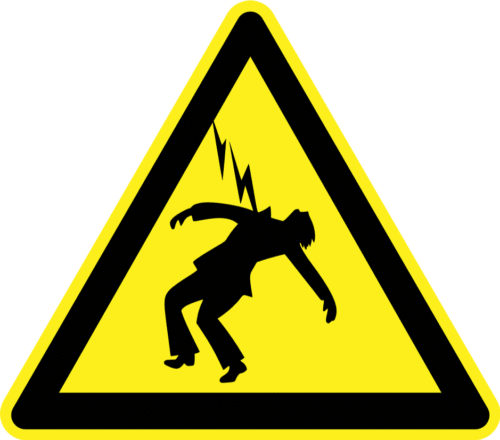Have you ever had an electric shock? Well, many people think that DC current is more dangerous than AC current as far as an Electric shock is concerned. Let’s find the answer, which is more dangerous AC or DC?

But Before that, let’s understand the basics of AC and DC current. We have a detailed article on AC and DC Current
AC Current
An alternating current flow in the sinewave (as shown in the figure below) pattern. The current switches direction back and forth. We can find an AC current in household appliances, lights, fans, etc.

DC Current
Direct current flows in only one direction (shown below). It can be found in electronic circuits, batteries, etc.

Let me tell you that apart from the type of current, the severity of an electric shock depends on other factors also. Such as,
Amount of Current
For example, an electric shock with an alternating current of 15 to 20 milliamperes can be extremely painful. However, an electric shock with 100 milliamperes may cause death.

Path of Current
The current passing from the right hand to the right leg can be painful. But when it passes from the right hand to the left hand through the heart may cause ventricular fibrillation. This condition is usually fatal.

Time Duration
An electric shock with a small amount of current (e.g. 0.3 milliamperes) can also cause a painful effect if it is held for a longer duration.
Body Resistance
The resistance offered by the wet body to electric shock is less as compared to the dry body.

Why Does the Human Body Feel an Electric Shock?
This is quite interesting to know. The current penetrates the body through the skin. The outermost layer of the skin epidermis is composed of a protein material called keratin.
Keratin offers the highest resistance to the passage of electricity. After the epidermis layer, we have sweat glands and then blood vessels. These sweat glands and blood vessels constitute of various ions, which are good conductors of electricity.
Hence, blood vessels and sweat glands offer low resistance to the passage of electricity.
Now the question arises, how current reaches and travels through the body?
Answering the above question, the outermost layer of the skin epidermis acts as a dielectric, the internal sweat glands and tissues act like one plate of capacitors, and a metal piece carrying electric current acts like another plate of the capacitor. Due to this capacitive effect, current passes through the body. Rapidly changing voltage allows more current to pass through the body.
Which Current is More Dangerous, AC or DC?
There are arguments in favor of both AC current and DC current. These arguments are based on experiments and studies carried out on human beings (including men and women) and industry professionals who have experience working with both types of currents.
The argument in favour of DC current
Victims who have experienced the electric shock with DC current say that they are unable to pull their hand back because DC current flows continuously. This effect is similar to an electric doorbell supplied with DC current. Hence, it is believed that the DC current shock is more dangerous.
Whereas, in the case of AC current, the person experiencing the electric shock can pull their hand back as the current goes to zero. Hence, it is believed that the AC current shock is least dangerous than the DC current.
The argument in favour of AC current
When the person is experiencing an electric shock, the focus of that person is to get rid of it and save their life. What is happening internally to the muscles cannot be known.
According to Charles Dalziel’s experiments on men and women, muscle contraction is continuous in case of an electric shock with a DC current. Whereas in the case of AC current, a person experiencing electric shock undergoes a series of muscle contractions. A series of muscle contractions cause very severe damage to the muscles.
Due to the capacitive behavior of the skin coming in contact with the current-carrying conductor, more current can pass through the body if the voltage is rapidly changing. Studies have shown that a twofold increase in the voltage increases a sevenfold increase in the current.
DC’s “let-go” threshold is higher than the AC’s “let-go” threshold. More DC current is required to produce a similar effect as AC current.
These arguments are not only based upon experiments being carried out on men and women but also have been studied medically. Hence, the argument in favor of AC current holds the truth.
Now, it can be summarized that AC Current is more dangerous than DC Current.
Well, one should not be afraid of electricity, but one must remember that both AC current and DC current can be dangerous to the human body, and safety measures must be taken into consideration when working with any of them.
References
- W. B. Kouwenhoven and O. R. Langworthy, “Effects of Electric Shock-II”. IEEE Transaction (A.I.E.E.).
- Charles F. Dalziel, “Effects of Electric Shock on Man”.
- W. B. Kouwenhoven and D. R. Hooker, “Electric Shock Effects of Frequency”.
- John Cadick, “Electrical Safety Handbook”, 3rd edition, Mcgraw Hill.
- Raymond M. Fish and Leslie A. Geddes, “Conduction of Electrical current to and Through the Human Body”, Open Access Journal of Plastic Surgery.
- Charles F. Dalziel and Eric Odgen, “Effects of Frequency on Let-Go Currents”, IEEE Transaction.
- Mark W. Kroll and Dorin Panescu, “Physics of Electrical Injury”, Springer Science+Business Media New York, 2012.
Krunal Shah is a passionate educator and career counselor with experience as an Entrepreneur. Currently, he is working as Director of Subodh Tech Private Limited, where he is involved in providing job-oriented training and Engineering Consultancy.







So far i knew that >30 milliampere will cause to death, but you are telling with 100 milliampere which is correct?
30mA
Very interesting article….I enjoyed it…..
What about the risk of having an electrical shock, is there any difference between AC/DC?
PD: really nice article by the way
Informative and interesting article. If author includes the results and after effects into article, it could be more better.
any way good efforts.
During my working day 2004 when I was in middle east my friend suffering from knee rheumatic disease he took the 220AC and put it on his knee I have seen his leg shaking but nothing happen to him and his rheumatic knee feels ok.
the frequency had to be high. high frequency can only burn, not shock.
Edit: only High Voltage with high frequency can cause burns (this excludes 110VAC to 220VAC)
30mA
Wow
Thank you for your feedback.
Thanks to Mr. Krunal Shah and EFY for wonderful article. I never come across such a beautiful article on electric shock. Different versions i have read in RCCB /ELCB manuals. But this article is very good.
What a tasteful article. I actually enjoyed it..
Thank You for your feedback.
just for readers low intense pulsating shocks are used for many medical applications .
It is very interesting article. Your explanations has a logical flow which makes me read it very comfortably.
Thank you so much!
Thank You for your feedback.
Based on the information on your article the epidermis acts like a dielectric , blood vessels act as one plate of a capacitor while the conductor we touch constitutes the second plate of the capacitor. More over ,it is known that the reactance of a capacitive element is inversely proportional to frequency. Hence ,since the frequency of an ac is higher than that of dc (actually 0 Hz),the reactance that our body offers will be less for ac than it does for dc. Less reactance means more current can pass via our body,in turn, more shock.
Xc = (-j)/(2*pi*f) ,where Xc =capacitive reactance
pi=22/7
f= system frequency (50 or 60 Hz).
What most people don’t realize with AC voltage and getting shocked is that you’re receiving more voltage than you may realize. When you’re shocked with the standard United States 60hz 120VAC residential power, that rating is the RMS value. Similar to an average value. However, technically when you receive an electric shock you’re getting the entire swing of the sine wave. Peak to peak voltage. ⚡️ For 120 RMS the peak value is 170 VAC peak. Peak to peak is twice that, at 340 VAC peak to peak!
So, in reality, you are feeling 340 volts ⚡️ in total. 👌👍